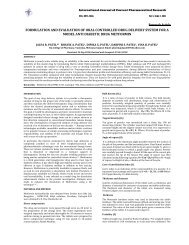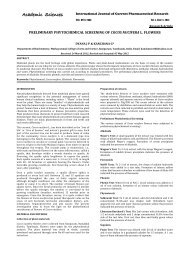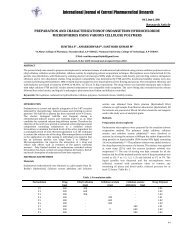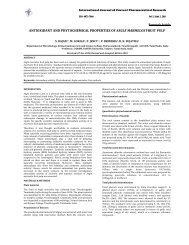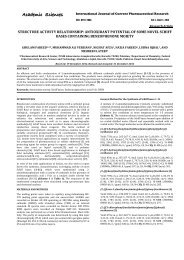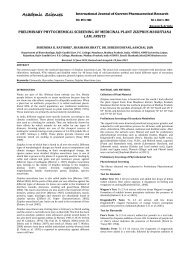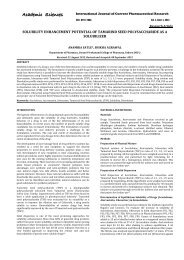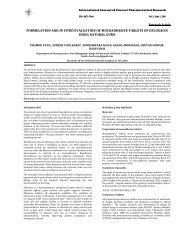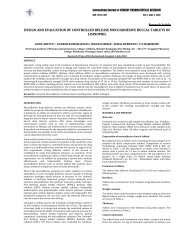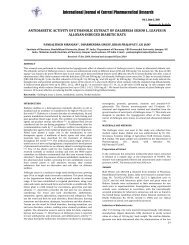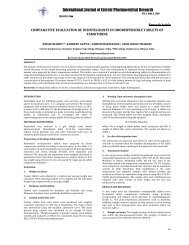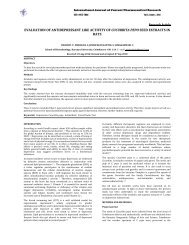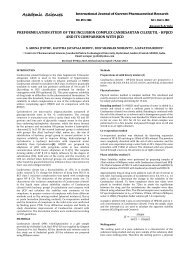phytochemical investigation and antioxidant activity study of drynaria ...
phytochemical investigation and antioxidant activity study of drynaria ...
phytochemical investigation and antioxidant activity study of drynaria ...
Create successful ePaper yourself
Turn your PDF publications into a flip-book with our unique Google optimized e-Paper software.
International Journal <strong>of</strong> CURRENT PHARMACEUTICAL RESEARCHISSN- 0975-1491 Vol 2, Issue 4, 2010Research ArticlePHYTOCHEMICAL INVESTIGATION AND ANTIOXIDANT ACTIVITY STUDY OF DRYNARIAQUERCIFOLIA LINN RHIZOMEARUN KUMAR BEKNAL 1 , PRAKASH G KORWAR 2 , M.A. HALKAI 1 , UPENDRA KULKARNI 2* , BASAWARAJ S.PATIL 2 ,SRINIVAS R. SOODAM 21HKES’S College <strong>of</strong> Pharmacy, Gulbarga, 2 RMES’S College <strong>of</strong> Pharmacy, Gulbarga. Email: upendra613@gmail.comReceived: 19 Jun 2010, Revised <strong>and</strong> Accepted: 17 July 2010ABSTRACTIn the present research <strong>investigation</strong> we extracted the powdered rhizome <strong>of</strong> Drynaria quercifolia linn by soxhlation method using different solvents.Then extracts were subjected to preliminary phyto‐chemical <strong>investigation</strong> followed by evaluation <strong>of</strong> anti‐oxidant <strong>activity</strong> by DPPH assay method. Itwas observed that, the methanolic extract was found to be effective anti‐oxidant on comparision to the other extracts <strong>and</strong> has significant <strong>activity</strong>compared to the st<strong>and</strong>ard drug.Keywords: Drynaria quercifolia, Anti‐oxidant, Methanol,INTRODUCTIONTraditional medicines played an important role in the health careneeds <strong>of</strong> India <strong>and</strong> other countries for thous<strong>and</strong>s <strong>of</strong> years. Recentlytraditional Indian <strong>and</strong> herbal drugs have gained popularity ininternational medical, biomedical <strong>and</strong> pharmaceutical institutions asa potential source <strong>of</strong> valuable medicinal agents. The effectiveness <strong>of</strong>Indian tradition <strong>and</strong> herbal drug products in the treatment <strong>of</strong> avariety <strong>of</strong> ailments <strong>and</strong> diseases has been established empiricallyover thous<strong>and</strong>s <strong>of</strong> years <strong>of</strong> historic use. However scientific data ontheir efficacy, pharmacological properties <strong>and</strong> action mechanism aswell as on their chemical constituents have so far been lacking. Herein this work we recognize the importance <strong>of</strong> using establishedmodern scientific methods <strong>and</strong> criteria to characterize thesemedicines, so that their full medicinal potential can be harnessed<strong>and</strong> new insights into diseases process can be uncovered.Antioxidants are substances, which act as body’s first line <strong>of</strong> defenseagainst unwanted damage by reactive oxygen species. It has beensuggested that the ingestion <strong>of</strong> dietary <strong>antioxidant</strong>s suppress thefree radical production or scavenge free radicals <strong>and</strong> may preventharmful effect <strong>of</strong> these radicals. Some <strong>phytochemical</strong>s i.e., flavanoids,pigments, <strong>and</strong> antioxidative vitamins are known to be potent<strong>antioxidant</strong>s. Even though there are, so many uses <strong>of</strong> the rhizome <strong>of</strong>Drynaria quercifolia Linn 1 (Polypodiaceae) has mentioned in theauthorative books, but no experimental evidence are reported.Hence in this <strong>study</strong> an attempt was made to prove the Anti‐oxidant<strong>activity</strong> <strong>of</strong> rhizome <strong>of</strong> Drynaria quercifolia Linn.Fig. 1: Plant, Rhizomes <strong>and</strong> leaves <strong>of</strong> Drynaria quercifoliaDrynaria quercifolia Fam: Polypodiaceae 2 (Asvakatri) is foundthroughout India, especially in the plains or very low down in themountains, On trees or rocks. South China, Malaysia <strong>and</strong> TropicalAustralia. An epiphytic fern with short thick fleshy creepingrhizome. 2cm or more thick, the young parts densely scaly, scalesvery dark brown, to about 2cm long narrowed gradually from thepeltate base to the very narrow apes not stiff edges pale <strong>and</strong> closely<strong>and</strong> finely toothed. Nest leaves 40 cms long <strong>and</strong> 30 cm wide, lobedat depth <strong>of</strong> 2‐5cm, lobes are broad <strong>and</strong> rounded. Stripes <strong>of</strong> foliageleaf about 30cm long; lamina to about 100cm long <strong>and</strong> 40cm wide,lobed to less than 1cm from the mid rib; oblique 25cm long <strong>and</strong>4.5cms wide, rather shortly acuminate, separated by rather narrowsinuses, thin but stiffly leathery in texture.Rhizome is used in diseases like janu roga, sopha, dusta vranamswasa, kasa, s<strong>and</strong>hi sopha, jwara, siratida, suryavarta. 3 Fronds areused for poultice swellings <strong>and</strong> the water extract possessedantibacterial properties. 4 The plant is known to have therapeuticuses in tuberculosis, fever, dyspepsia <strong>and</strong> cough. The fronds haveastringent properties. The fronds are pounded <strong>and</strong> used as apoultice for swelling because <strong>of</strong> its antibacterial <strong>and</strong> astringentproperties. 5 Rhizome <strong>and</strong> roots is used as tonic in typhoid fever <strong>and</strong>dyspepsia 6 Traditional use <strong>of</strong> this drug in diarrhea, typhoid, cholera,jaundice, fever, headache, skin diseases <strong>and</strong> syphilis. 7 It single isfound to strengthen <strong>and</strong> promote the repair <strong>of</strong> sinews, muscles <strong>and</strong>bones. They are effective for lower back <strong>and</strong> ligament injuries. 8 Inanother combination <strong>of</strong> drug, Drynaria is used for expellingrheumatism. 10 Drynaria rhizome is used topically in traditionalChinese medicine to stimulate hair growth <strong>and</strong> to treat baldness. Inthe treatment <strong>of</strong> hyperthyroidism. Drynaria along with other drugsare used. In these conditions <strong>drynaria</strong> is used externally as well asinternally. 11 D. quercifolia along with other combination <strong>of</strong> herbs isused in pain from traumatic injury, such as sprains <strong>and</strong> contusionswith bruising <strong>and</strong> swelling. 12MATERIALS AND METHODSCollection <strong>of</strong> plant materialThe rhizome <strong>of</strong> Drynaria quercifolia linn (Fam: Polypodiaceae) werecollected from Updi District in the month <strong>of</strong> April 2008 <strong>and</strong>
Beknal et al.Int J Curr Pharm Res, Vol 2, Issue 4, 3639authenticated by Dr.Gopalkrishna Bhatt, Pr<strong>of</strong>essor, Sri poornaprajnacollege, Udupi, Mangalore, Karnataka, India. The plant material wasdried, powdered <strong>and</strong> stored in air tight containers until furtherstudies.Proximate analysis 13Determination <strong>of</strong> total ash valueAccurately weighed 5gms <strong>of</strong> powdered rhizome <strong>of</strong> Drynariaquercifolia Linn (Polypodiaceae) was taken in a dried silica crucible.It was incinerated at temperature 450°C, until free from carbon <strong>and</strong>then cooled. The weight <strong>of</strong> total ash was taken <strong>and</strong> the percentage <strong>of</strong>it was calculated with reference to the air dried sample.Determination <strong>of</strong> acid insoluble ash valueThe total ash obtained was boiled for 5 mins with 25 ml <strong>of</strong> 2N HCI,filtered <strong>and</strong> the insoluble matter was collected on ash less filterpaper. Then it was washed with hot water, ignited in tarred cruciblecooled <strong>and</strong> the residue obtained was weighed. Finally thepercentage <strong>of</strong> acid insoluble ash was calculated with reference to theair dried drug.Determination <strong>of</strong> water soluble ash valueThe total ash obtained was boiled with 25 ml <strong>of</strong> water for few mins.The insoluble matter was collected on ash less filter paper, washedwith hot water <strong>and</strong> ignited for 15 mins at temperature not exceeding450°C. The difference in weight represents the water soluble ash.The percentage <strong>of</strong> water soluble ash was calculated with referenceto the air dried drug.Determination <strong>of</strong> extractive valueDetermination <strong>of</strong> alcohol <strong>and</strong> water soluble extractive value20 gms <strong>of</strong> air dried, coarsely powdered rhizome <strong>of</strong> Drynariaquercifolia linn powdered was macerated with 100 ml <strong>of</strong> alcohol(90%) in a closed flask for 24 hrs, shaking frequently during the first6hrs <strong>and</strong> was allowed to st<strong>and</strong> for 18 hrs Then it was filtered rapidly<strong>and</strong> precautions were taken against loss <strong>of</strong> alcohol. 25m1 <strong>of</strong> thefiltrate was evaporated to dryness in a tarred flat bottomed shallowdish, dried at 105°C <strong>and</strong> weighed. The percentage <strong>of</strong> alcohol solubleextracts were calculated with reference to the air dried drug. Theprocedure followed as above using chlor<strong>of</strong>orm water instead <strong>of</strong>alcohol.Determination <strong>of</strong> moisture contentAccurately weighed 5gms <strong>of</strong> powdered rhizome <strong>of</strong> Drynariaquercifolia linn was taken in a china dish. It was kept for 30 mins in ahot air oven at 105 ‐ 110°C. The percentage <strong>of</strong> moisture content wasthen calculated with reference to the air dried drug at differenttimes.Sequential extraction <strong>of</strong> the drug Drynaria quercifolia rhizomeThe method is based on the extraction <strong>of</strong> active constituents presentin the drug using various solvents ranging from non‐polar to polar.The solvents used are petroleum ether, chlor<strong>of</strong>orm, methanol <strong>and</strong>water.The successive solvent extraction procedure was adopted for thepreparation <strong>of</strong> various extracts <strong>of</strong> Drynaria quercifolia rhizome. Thematerials were subjected to successive extraction with solvents intheir ascending order <strong>of</strong> polarity in this process the substance,which is soluble in a solvent with particular range <strong>of</strong> polarity wasextracted in the solvent <strong>and</strong> remaining marc further extracted withnext solvent.The 2 kg powdered drug was taken <strong>and</strong> subjected for successivesolvent extraction The extraction was carried out for 18 hrs withthe following solvents in the increasing order <strong>of</strong> the polarity i.e.Petroleum ether, chlor<strong>of</strong>orm, methanol <strong>and</strong> distilled water.Preparations <strong>of</strong> petroleum ether extractAbout 2kg <strong>of</strong> dried roots powder <strong>of</strong> Drynaria quercifolia rhizomewas extracted with 600 ml <strong>of</strong> petroleum ether using Soxhletapparatus for 18 hrs at 60‐80°C. The extract was concentrated to1/4 <strong>of</strong> its original volume by distillation as it was adopted to recoverthe solvent, which could be used again for extractions.Preparation <strong>of</strong> chlor<strong>of</strong>orm extract: After pet ether extraction, theremaining dried marc was extracted with chlor<strong>of</strong>orm to getchlor<strong>of</strong>orm extract.Preparation <strong>of</strong> methanol extract: After chlor<strong>of</strong>orm extraction, theremaining dried marc was extracted with methanol to get methanolextract.Preparation <strong>of</strong> aqueous extract: After methanol extraction, theremaining dried marc was extracted with water to get water extract.For the preparation <strong>of</strong> aqueous extract, the above dried marc wasmacerated for 3 days with distilled water <strong>and</strong> the residue wasremoved by filtration <strong>and</strong> filtrate was concentrated to obtainaqueous extractAll the extracts were concentrated by distillation <strong>of</strong>the solvent <strong>and</strong> evaporating them to dryness at low temperature.They were then weighed <strong>and</strong> the percentage <strong>of</strong> different extractivevalues was calculated in terms <strong>of</strong> air dried weight <strong>of</strong> the plantmaterial.Preliminary <strong>phytochemical</strong> screeningThe powdered root was subjected to systematic <strong>phytochemical</strong>screening by successively extracting them in different solvents <strong>and</strong>testing for the presence <strong>of</strong> chemical constituents.Qualitative chemical examination <strong>of</strong> extractsDetection <strong>of</strong> alkaloidsExtracts were dissolved individually in dilute hydrochloric acid <strong>and</strong>filtered. The filtrates were tested carefully with alkaloid reagents.a. Mayer’s Test: Filtrates were treated with Mayer’s reagent(potassium mercuric iodide). The formation <strong>of</strong> a yellow creamprecipitate indicated the presence <strong>of</strong> alkaloids.b. Wagner’s Test: Filtrates were treated with Wagner’s reagent(iodine in potassium iodide) <strong>and</strong> observed. Formation <strong>of</strong>brown or reddish brown precipitate indicated the presence <strong>of</strong>alkaloids.Detection <strong>of</strong> flavonoidsLead acetate Test: The extracts were treated with few drops <strong>of</strong>10% lead acetate solution. The formation <strong>of</strong> yellow precipitateconfirmed the presence <strong>of</strong> flavonoidsDetection <strong>of</strong> proteins <strong>and</strong> amino acidsa. Millons Test The e tracts were treated with 2 ml <strong>of</strong> Millonsreagent The formation <strong>of</strong> white precipitate, which turned tored upon heating, indicated the presence <strong>of</strong> proteins <strong>and</strong> aminoacids.b. Biuret Test: The extract: were treated with 1ml <strong>of</strong> 10%sodium hydroxide solution <strong>and</strong> heated. A drop <strong>of</strong> 0.7% coppersulphate solution to the above mixtures was added. Theformation, <strong>of</strong> purplish violet color indicated the presence <strong>of</strong>proteins.Evaluation <strong>of</strong> <strong>antioxidant</strong> <strong>activity</strong>D.P.P.H Method 13 (Blios MS. 1958, Free radical scavenging potential<strong>of</strong> extracts was tested against a methanolic solution <strong>of</strong> DPPH (α, α‐diphenyl ‐ β ‐ picryl hydrazyl) <strong>antioxidant</strong>s react with DPPH <strong>and</strong>convert it to α, α‐diphenyl‐ β ‐ picryl hydrazine. The degree <strong>of</strong>discoloration indicates the scavenging potentials <strong>of</strong> the <strong>antioxidant</strong>extract. The change in the absorbance produced at 517nm has beenused as a measure <strong>of</strong> <strong>antioxidant</strong> <strong>activity</strong>.α, α diphenyl β picryl hydrazyl` α, αdiphenyl β picryl hydrazine37
Beknal et al.Int J Curr Pharm Res, Vol 2, Issue 4, 36395. Glossary <strong>of</strong> Indian medicinal plants by Chopra R.N, Chopra I.C,Nayar S.L. Pub. Publications <strong>and</strong> information directorate CSIR(science <strong>and</strong> culture 1950‐51, 232; Burkil I‐862)6. Viswanatha. M.B. Industry meet cum seminar on Bio‐diversity<strong>and</strong> Information on medicine <strong>and</strong> aromatic plants.7. Z.Z‐Yue Hygiene medicine licence E.c. No. 116050. Patent No.ZL 943086.8. Ran Ruijin, from Dah medical college, yunnab province 671000,China.9. Am j Chin. Med. 1996.24(1): 77‐82.10. Lu weiming, clinical <strong>investigation</strong> on treatment with integratedtraditional <strong>and</strong> Western medicine in hyperthyroidism <strong>and</strong>leukocytopenia induced by sulfourea drugs, Chinese Journal <strong>of</strong>Integrated Traditional <strong>and</strong> Western medicine. 1998.11. Elixir Tonics <strong>and</strong> Teas, (310) 867‐9300‐ Revised, July1999,Botanic Health Resources.12. Ramesh N et al. Phytochemical <strong>and</strong> antimicrobial studies onDrynaria quercifolia.13. Tanaka T, Nonaka G <strong>and</strong> Nishioka I. Punicafolin, an ellagitanninfrom the leaves <strong>of</strong> Punica granatum. Phytochemistry. 1985;24(9): 2075‐2078.39



